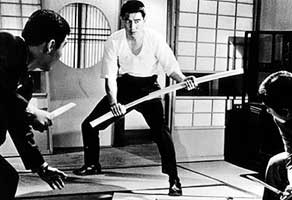 The Abashiri Prison series marked the beginning of Ken Takakura's meteoric rise of popularity, so the early films of the series are important for understanding the curve of his success. The Abashiri Prison series marked the beginning of Ken Takakura's meteoric rise of popularity, so the early films of the series are important for understanding the curve of his success.
However, these first few episodes are not great films. The kind of tragic-visaged chivalrous gangster Ken would soon perfect was not as yet fully formed. Still, he's one gorgeous fellow whom all Japan embraced in the 1960s & 1970s as the perfect ideal of Japanese manliness, sensitive & strong & just totally handsome & buff.
And if these ex-con films aren't the best he would do, even so, for just long as Ken at least sings that yakuza-enka (gangster folk song) on the sound track, there's always be at least that one thing that is grand.
The actual prison dates to the Meiji Era, in a desolate area of Hokkaido surrounded by snow, as deadly & difficult to escape from as Alcatraz or Devil's Island. It was not such a famous place before Ken starred in the long-running film series about yakuza who served time in that place, but it is today a major tourist attraction with a prison museum, & that is thanks mainly to Ken.
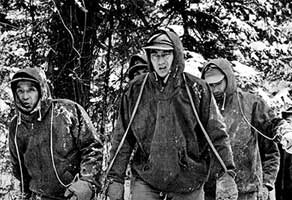 The first three in the series all appeared in 1965, with three more in 1966, quickies directed by Teruo Ishii who would do ten of them before turning the series over to other hands. The very first Abashiri bangaichi aka The Man from Abashiri Jail was a black & white cheapy, yet a surprise hit for Toei Studios which was always swift to cash in on a good thing, with a habit of revisiting any cash-cow as often as the studio could get away with it. The first three in the series all appeared in 1965, with three more in 1966, quickies directed by Teruo Ishii who would do ten of them before turning the series over to other hands. The very first Abashiri bangaichi aka The Man from Abashiri Jail was a black & white cheapy, yet a surprise hit for Toei Studios which was always swift to cash in on a good thing, with a habit of revisiting any cash-cow as often as the studio could get away with it.
The supporting cast includes Tetsuro Tamba as the warden who liked our hero then was angrily disappointed in him; Toru Abe as the evil yard boss; rubber-faced charmer Kunie Tanake, & as the prison's aging but strong oyabun or gangster boss, Kanjuro Arashi.
Ken plays Shinichi Tsukibana, a good guy serving three years & approaching the end of his time. After introducing the viewer to prison life, the tale takes a sudden change in direction when Tsukibana against his choice escapes from Abashiri Prison handcuffed to the dangerous Gunda (Hiroshi Nanbara), who instigated the escape. Thus tethered, they start out on a journey across the desolate snow country of Hokkaido.
What keeps Tsukibana going is his desire to see his ailing mother, the "sensitive" touch to his character that would mark most of Ken's roles thereafter. Although this is not a great film, the acting is convincing & the vistas of Hokkaido shocking in their starkness. And as the starting point of Ken's enormous popularity, worth seeing.
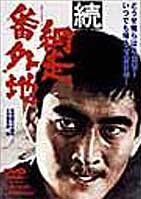 In the first sequel Zoku Abarishi bangaichi (Abashiri Prison Continued, shown originally in North America as The Green Ball Mystery) there's a downward turn in quality, probably due to the haste with which the original film crew & much of the same cast was grabbed back into a heap. This time the film got the full color treatment, which is actually a distraction as the black & white photography for the snow country was one of the finest aspects of the first installment. In the first sequel Zoku Abarishi bangaichi (Abashiri Prison Continued, shown originally in North America as The Green Ball Mystery) there's a downward turn in quality, probably due to the haste with which the original film crew & much of the same cast was grabbed back into a heap. This time the film got the full color treatment, which is actually a distraction as the black & white photography for the snow country was one of the finest aspects of the first installment.
Supporting cast includes Kanjuro Arashi again playing the oyabun Onitora & Kunie Tanake as Shinichi's amusing buddy.
As a yakuza-eiga go, this one is rather a silly film. When Ken has a script that requires him to look infinitely sad, he becomes truly iconic. But as a comedy performer he disappoints. A scene where he is trying to hawk ladies panties in the street examplifies the film's low level of humor. The serious aspect of ex-cons framed for jewel theft, trying to solve the mystery themselves, is developed with too many absurdities to be at all suspenseful.
The action scenes are mediocre & few. The final fight is a mud-wrestling scene beween Takakura's Shinichi & the villain (Toru Abe), lacking either humor or excitement. A tedious show overall, even for a die-hard yakuza-eiga fan & devottee of Ken Takakura. It's crappiness didn't keep it from being a great hit when released.
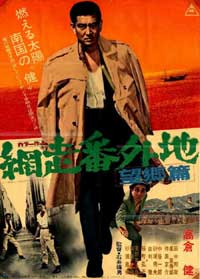 Part III was Abashiri bangaichi: Boukou-hen (Abashiri Prison: Longing for Home aka Duel on the Warf). It takes a small leap forward in quality of story. Much of the same cast returns, although mostly all they do is talk, & as in the previous installment, there is a derth of action. Part III was Abashiri bangaichi: Boukou-hen (Abashiri Prison: Longing for Home aka Duel on the Warf). It takes a small leap forward in quality of story. Much of the same cast returns, although mostly all they do is talk, & as in the previous installment, there is a derth of action.
Toru Abe is still a bad guy; Kanjuro Arashi still the the kindly oyabun, though doomed in this episode. The colorful & tubercular "Killer Joe" in his icecream suit is played by Naoki Sugiura, who will not permit Ken's Shinichi Tachibana to live a straight-laced life.
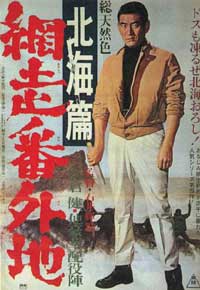 Set on the wharfs of Nagasaki rather than in Hokkaido, the climax is almost done right this time because Shinichi goes on a revenge raid with a sword. That's the climax that would be done in literally hundreds of films to follow during the rest of the decade & more. Those later films strove to outdo what came first, so the important clash in Duel on the Warf seems only tepidly violent in retrospect. Set on the wharfs of Nagasaki rather than in Hokkaido, the climax is almost done right this time because Shinichi goes on a revenge raid with a sword. That's the climax that would be done in literally hundreds of films to follow during the rest of the decade & more. Those later films strove to outdo what came first, so the important clash in Duel on the Warf seems only tepidly violent in retrospect.
The original Abashiri bangaichi quite obviously borrowed or stole from Sydney Portier & Tony Curtis's The Defiant Ones (1958). The fourth in the series, Journey into Danger or Abashiri bangaichi: Hokkai-hen (Abashiri Prison: Hokkaido Territory) takes some of its cues from Stagecoach (1939), but with laborers & gangsters in lieu of cowboys & a truck instead of a stagecoach.
Shinichi sets out to earn a few honest dollars with which to bail a friend out of jail, along the way taking down a pack of drug dealers, who'll get what they deserve in the final reel. This is a very spoofy episode, with a gay couple providing some of the humor, & a finger-cutting sequence in which the tip of the severed finger is eaten by chickens. Supporting cast includes Shinichi "Sonny" Chiba, Kanjuro Arashi, Kunie Tanaka, Eitaro Ozawa & Reiko Oharo.
Many more episodes would follow until number 17 arrived in 1972. But only the first nine are about Shinichi Tachibana. Though Ken plays an ostensibly different guy beginning in the tenth film, in all his traits he's the same, though the second cluster of films (eight in all) could be considered a different series.
copyright © by Paghat the Ratgirl
|
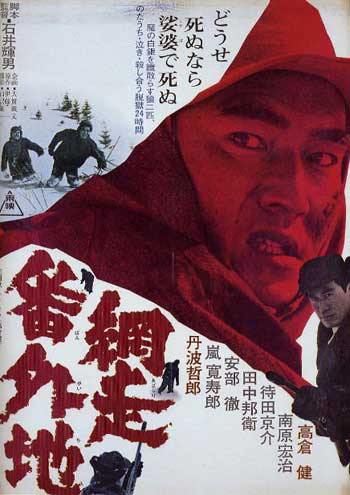

 The first three in the series all appeared in 1965, with three more in 1966, quickies directed by Teruo Ishii who would do ten of them before turning the series over to other hands. The very first Abashiri bangaichi aka The Man from Abashiri Jail was a black & white cheapy, yet a surprise hit for Toei Studios which was always swift to cash in on a good thing, with a habit of revisiting any cash-cow as often as the studio could get away with it.
The first three in the series all appeared in 1965, with three more in 1966, quickies directed by Teruo Ishii who would do ten of them before turning the series over to other hands. The very first Abashiri bangaichi aka The Man from Abashiri Jail was a black & white cheapy, yet a surprise hit for Toei Studios which was always swift to cash in on a good thing, with a habit of revisiting any cash-cow as often as the studio could get away with it.

 Set on the wharfs of Nagasaki rather than in Hokkaido, the climax is almost done right this time because Shinichi goes on a revenge raid with a sword. That's the climax that would be done in literally hundreds of films to follow during the rest of the decade & more. Those later films strove to outdo what came first, so the important clash in Duel on the Warf seems only tepidly violent in retrospect.
Set on the wharfs of Nagasaki rather than in Hokkaido, the climax is almost done right this time because Shinichi goes on a revenge raid with a sword. That's the climax that would be done in literally hundreds of films to follow during the rest of the decade & more. Those later films strove to outdo what came first, so the important clash in Duel on the Warf seems only tepidly violent in retrospect.